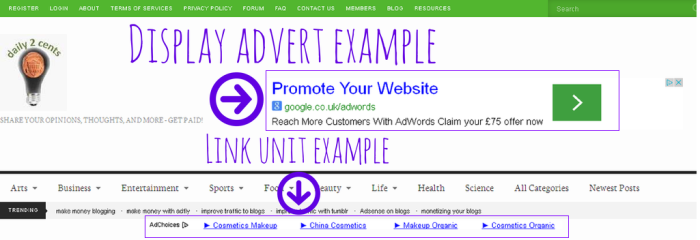Google Adsense is one of the most popular advertising platform on the internet. Publishers, such as bloggers, simply place the code onto their blog and then Adsense generates advertising revenue for them. The revenue comes both from advert clicks and for impressions, which is the number of times adverts are shown on your blog. Alongside the adverts, you can also place a Google search box on your blog to increase your earnings.
Getting started with Adsense is simple. Before you apply you’ll need a privacy policy in place. If you don’t already have one then there are plenty of example policies around. One of my favourite websites for generating an Adsense compatible privacy policy is Serp Rank – it also includes other advertising platforms such as Commission Junction and Amazon. Whilst there are no set rules for how many posts you need, or how old your blog is, it is advisable to wait until your blog is either 6 months old or has 70+ posts.
When you are ready to apply, you will need a Google account and then head to the Adsense homepage to get started. Once you’ve submitted your information, the Adsense team will manually approve your account. Once your account has been approved, you don’t need to apply again for additional websites. When you log in, you are able to see detailed statistics, which include your daily earnings, weekly earnings and the last 28 days earnings. You can also run various reports to help you figure out where your earnings are coming from.
Once you have made some money, you will need to confirm both your address and your bank account. To confirm your address, Google will send you a letter with a code and to confirm your bank details, they’ll put a small amount of money into your account (50p in my case). The minimum payout is £60 and it’ll probably be a few months before you reach the minimum payout.
Different advert types:
There are a few different advert types on offer with Adsense. They are available in most sizes, although the recommended sizes are 300×250, 336×280, 728×90 and 160×600. They are recommended because the advertisers might not make adverts in all sizes, but these are the most common sizes used – meaning that more advertisers are published on your website.
Display adverts are text or image adverts. You can choose to display text only, images only or both.
Link units are blocks of links without additional text or images.
You are only allowed to display a maximum of 3 display adverts and 3 link units per page.
What are RPM, CPC and CTR?
RPM stands for revenue per thousand impressions. This flactuates greatly across my four websites, and it is calculated by dividing your estimated earnings by your page views then multiplied by 1000.
CPC stands for cost per click, and it is the amount you earn each time a visitor clicks on your advert(s).
CTR stands for clickthrough rate, and it is the total number of advert clicks then divided by the number of page views you’ve received.
How to maximise your Adsense earnings:
Quite frankly, I wish I knew! I run four different websites and yet the one that receives the lowest traffic (under 50 page views a day at present) is earning me the most money. Considering another of my websites is getting between 1,000 -2,000 page views a day, that is a big difference. Having good quality content is always key to good earnings with Adsense, but you can also spend some time playing around with advert placement to see what works well for both you and your readers.
There are some great WordPress plugins that help you place Adsense adverts on your blog. My favourites are Adsense Now and Adsense widget. Adsense Now allows you to add code to each post and the widget allows you to easily display adverts in your sidebar.
Do you use Adsense? Have you found it to be a valuable earning tool?






Thank you so much for this post! I run a little blog and have been wondering about ways to make some pocket money from it for a while now. I’ll take your advice and wait a few months before I apply for Adsense and see what happens. x